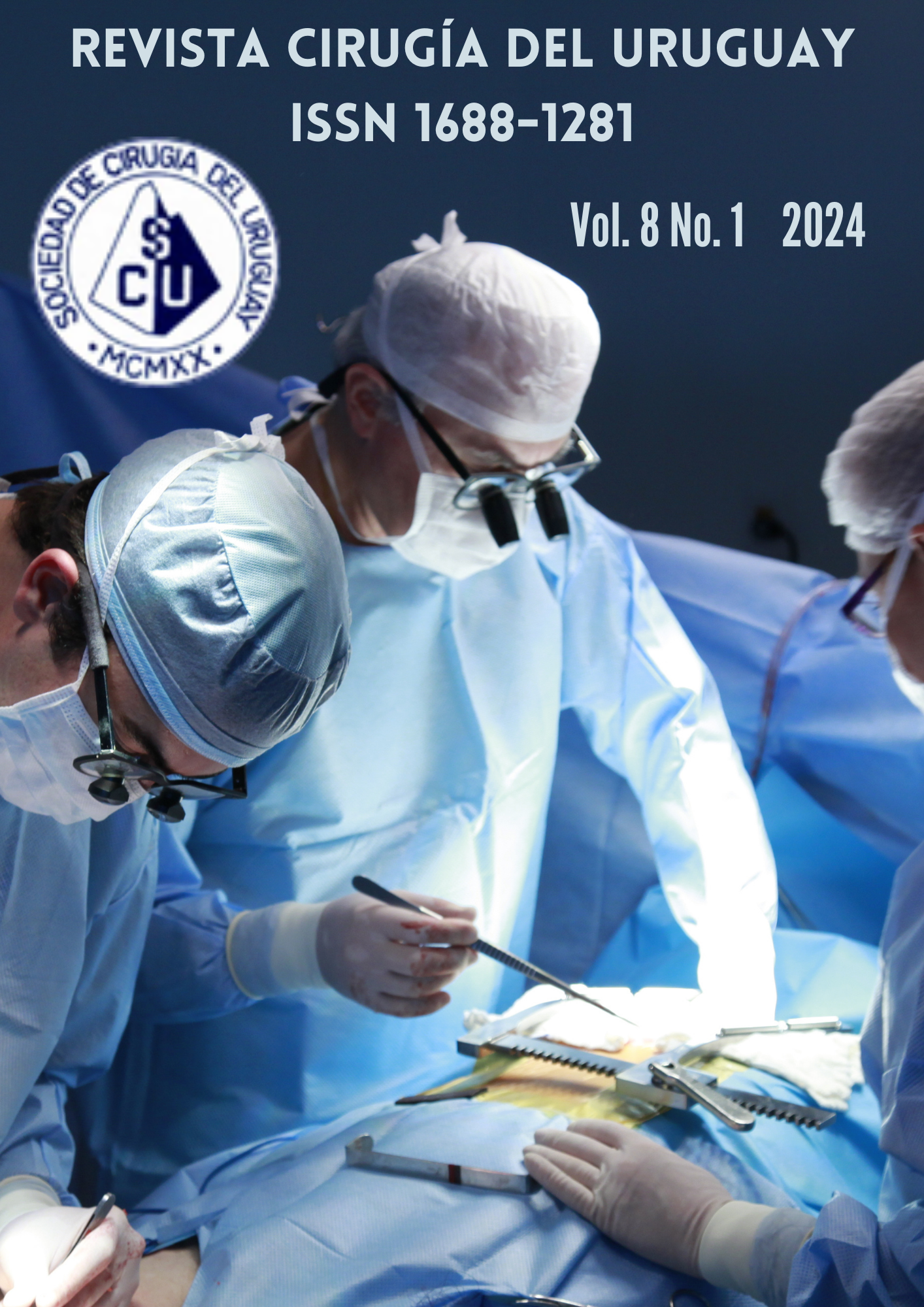Hepatocellular adenoma. About a case.
DOI:
https://doi.org/10.31837/cir.urug/8.1.2Keywords:
Adenoma, liver cell, liver diseases, surgery, diagnostic imagingAbstract
Hepatocellular adenoma (HA) is a benign liver tumor, its diagnosis has advanced thanks to advances in molecular methods, which facilitated its division into subtypes, with different prognoses and therapeutic indications. We present the clinical case of a 40-year-old patient with an ultrasound finding of a liver tumor, a voluminous heterogeneous solid lesion on a CT scan of the abdomen and pelvis, compatible with a steatotic adenoma on MRI (associated with HNF1 alpha mutation). Surgical treatment was decided, with resection of segments 6 and 7. The pathology concluded in short: Compatible with the inflammatory subtype. Hepatic adenomas (HA) are rare, solitary, benign epithelial tumors. They occur in women of childbearing age and associated with the consumption of oral contraceptives and estrogens. These tumors predominate in the right liver, with proliferation of cells similar to normal hepatocytes, but disorganized and without normal lobular architecture, without bile ducts or supporting connective tissue. HA, as well as the rest of the benign liver tumors, have increased their incidence in the hand with the advancement of abdominal imaging. The importance of differentiation with the rest of the benign liver tumors arises from the malignant potential of these. We can classify patients according to the molecular profile associated with immunohistochemical markers. Imaging studies are fundamental for tumor differentiation in diagnosis and therapeutic planning. The treatment will be individualized, determined by the clinic, the variety of subtypes, and the evolution. Due to the complexity of the disease, the treatment of AH is one of the best examples of an individualized approach in hepatobiliary units.
Downloads
Metrics
References
Baum JK, Bookstein JJ, Holtz F, Klein EW. Possible association between benign hepatomas and oral contraceptives. Lancet. 1973;302(7835):926-9. doi: 10.1016/s0140-6736(73)92594-4.
Gaspersz MP, Klompenhouwer AJ, Broker MEE, Thomeer MGJ, van Aalten SM, Steegers E, et. al. Growth of hepatocellular adenoma during pregnancy: A prospective study. J Hepatol. 2020;72(1):119-124. doi: 10.1016/j.jhep.2019.09.011.
Thomeer MG, Broker M, Verheij J, Doukas M, Terkivatan T, Bijdevaate, D, et. al. Hepatocellular adenoma: when and how to treat? Update of current evidence. Therap Adv Gastroenterol. 2016;9(6):898-912. doi: 10.1177/1756283X16663882.
Bioulac-Sage P, Balabaud C, Bedossa P, Scoazec JY, Chiche L, Dhillon AP, et. al. Pathological diagnosis of liver cell adenoma and focal nodular hyperplasia: Bordeaux update. J Hepatol. 2007;46(3):521-7. doi: 10.1016/j.jhep.2006.12.007.
Bioulac-Sage P, Balabaud C, Zucman-Rossi J. Will the pathomolecular classification of hepatocellular adenomas improve their clinical management? J Hepatol. 2011;55(1):8-10. doi: 10.1016/j.jhep.2011.01.016.
Miller GC, Campbell CM, Manoharan B, Bryant R, Cavallucci D, O'Rourke N, et. al. Subclassification of hepatocellular adenomas: practical considerations in the implementation of the Bordeaux criteria. Pathology. 2018;50(6):593-599. doi: 10.1016/j.pathol.2018.05.003.
Gatti M, Maino C, Tore D, Carisio A, Darvizeh F, Tricarico E, et. al. Benign focal liver lesions: The role of magnetic resonance imaging. World J Hepatol. 2022;14(5):923-943.doi: 10.4254/wjh.v14.i5.923.
Herman P, Fonseca GM, Kruger JAP, Jeismann VB, Coelho FF. Guidelines for the Treatment of Hepatocellular Adenoma in the Era of Molecular Biology: An Experience-Based Surgeons' Perspective. J Gastrointest Surg. 2021;25(6):1494-1502. doi: 10.1007/s11605-020-04724-1.
Kim SM, Hwang S, Ahn CS, Kim KH, Moon DB, Ha TY, et. al. Clinicopathological features and post-resection outcomes of hepatocellular adenoma. Ann Hepatobiliary Pancreat Surg. 2021;25(1):25-33. doi: 10.14701/ahbps.2021.25.1.25.
Ramia JM, Bernardo C, Valdivieso A, Dopazo C, Jover JM, Albiol MT et al. Estudio multicéntrico sobre adenomas hepáticos. Cir Esp. 2014;92(2):120–125.Doi: 10.1016/j.cireng.2012.12.005.
Fodor M, Primavesi F, Braunwarth E, Cardini B, Resch T, Bale R, et. al. Indications for liver surgery in benign tumours. Eur Surg. 2018;50(3):125-131. doi: 10.1007/s10353-018-0536-y
Herman P, Fonseca GM, Kruger JAP, Jeismann VB, Coelho FF. Laparoscopic liver resection for benign tumors: the current position. Arq Bras Cir Dig. 2022;34(4):e1641. doi: 10.1590/0102-672020210002e1641.
Van Vledder MG, van Aalten SM, Terkivatan T, de Man RA, Leertouwer T, Ijzermans JN. Safety and efficacy of radiofrequency ablation for hepatocellular adenoma. J VascIntervRadiol. 2011;22(6):787-93. doi: 10.1016/j.jvir.2011.02.024.
Downloads
Published
How to Cite
Issue
Section
License

This work is licensed under a Creative Commons Attribution 4.0 International License.
All articles, videos and images published in Revista Cirugía del Uruguay are under the Creative Commons CC licenses, which is a complement to the traditional copyright, in the following terms: first, the authorship of the referred document must always be acknowledged and secondly none of the article or work published in the journal may have commercial purposes of any nature. The authors retain their copyrights and give the magazine the right of first publication of their work, which will be simultaneously subject to the Creative Commons Attribution-NonCommercial 4.0 International License license that allows the work to be shared whenever the initial publication is indicated in this journal.






























